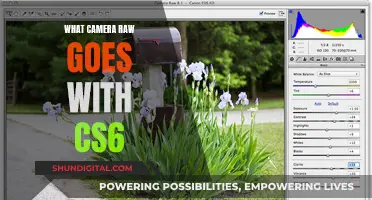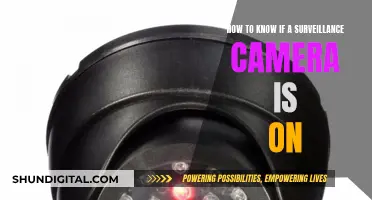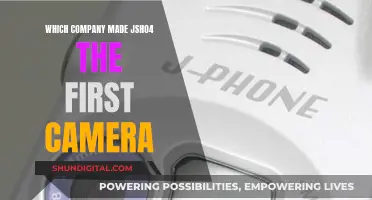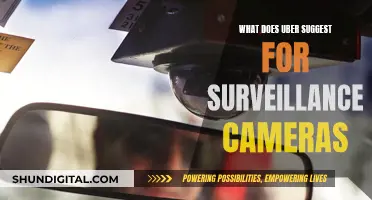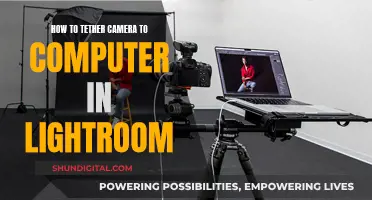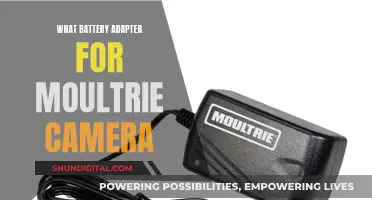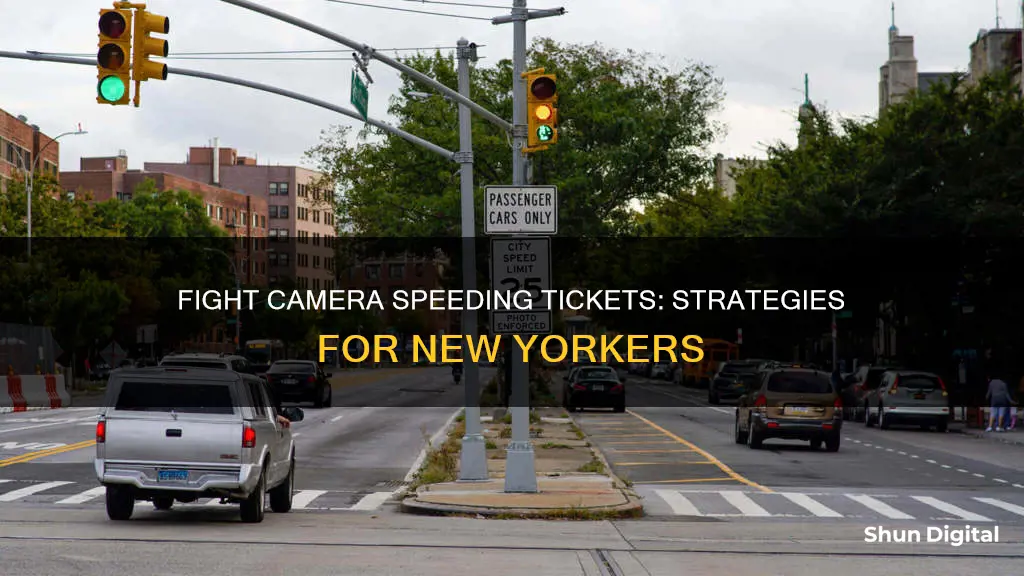
If you've received a speeding ticket in New York, there are several ways to dispute it. Firstly, you must plead not guilty to the charge and do so before the deadline, which is usually around 30 days. You can do this online, by mail, via a mobile app, or in person. Disputing a ticket in New York begins the legal process, and you may be required to attend a hearing. It's important to note that paying the fine before court or pleading guilty will mean you are unable to fight the ticket.
| Characteristics | Values |
|---|---|
| Ways to dispute a ticket | Online, by mobile app, by mail, or in-person |
| Time to dispute a ticket | 30 days |
| Ticket fine | $50 |
| Additional penalty | $25 |
| Online hearing time | 45 days |
| Online hearing decision | Sent via email from NYCServ@finance.nyc.gov |
| Mobile app | NYC Parking Ticket Pay or Dispute |
| Mail address | NYC Department of Finance, Hearing by Mail Unit, P.O. Box 29021, Brooklyn, NY 11202-9021 |
| DOF Business Center locations | Open Monday to Friday, 8:30 a.m. to 4:30 p.m. |
| Evidence | Dashcam footage, video evidence, written defense, photo or video evidence, etc. |
| Radar guns | Need to undergo routine calibrations |
| Plea | Not guilty |
What You'll Learn

Plead not guilty to begin the dispute process
If you want to dispute a speeding ticket in New York, you must plead not guilty. This is the only way to possibly obtain a more favorable outcome. You can plead not guilty by mail, online, or in person. You must do this within 30 days of receiving the ticket to avoid a $25 late fee.
When you plead not guilty, you place the burden of proof on the prosecution. This means they must prove each element of your violation—it's not your responsibility to prove that you didn't do it. You can request a full trial, which may require you to attend other hearings such as pre-trial hearings or mediation. You can also request a Supporting Deposition from the police officer who issued the ticket. This will provide you with additional information about the basis for the ticket.
At your hearing, you can present your defense. For example, you can argue that:
- You weren't the one driving.
- The photo of your car is blurry and doesn't clearly show your license plate.
- There's no proof that the camera or speed detection equipment was functioning properly.
- You have a strong case with physical proof that you weren't speeding, such as dashcam footage or GPS data.
- You have an unblemished driving record.
Charging Your Panosphere Camera: How Long is Enough?
You may want to see also

Argue that the camera malfunctioned
Arguing that a Camera Malfunctioned to Beat a Speeding Ticket in New York
If you want to beat a speeding ticket in New York, you can argue that the camera malfunctioned. Here's how to do it:
Step 1: Examine Your Ticket
Check the date, time, and location of the ticket. Make sure you were actually driving the car when the ticket was issued. Generally, the prosecutor must prove that you were driving in that location at that specific date and time. If someone else was driving your car, you cannot be prosecuted.
Step 2: Plead Not Guilty
You must plead not guilty if you want to dispute the ticket. You can do this by mail, online, or in person. Check your citation and make sure to plead not guilty before the deadline, which is usually within 30 days of receiving the ticket.
Step 3: Request a Formal Hearing
When you plead not guilty, demand a full formal hearing or trial. This is where you will present your defense and argue that the camera malfunctioned.
Step 4: Gather Evidence
Request copies of the photos taken by the camera, as well as maintenance records for the camera and speed monitoring system. Look for any signs of malfunction or lack of calibration. For example, if the camera was not calibrated within a reasonable time frame before your ticket was issued, you can argue that the camera may not have been accurate.
Step 5: Present Your Defense
Arrive at the courthouse on the day of your hearing with copies of any evidence you have. Present your argument that the camera malfunctioned and provide any supporting evidence. Treat the judge and courthouse staff with respect, and remain calm and professional throughout the hearing.
Remember, it is the prosecution's burden to prove that you were speeding, not your responsibility to prove that you weren't. If they cannot provide sufficient evidence or if there are signs of camera malfunction, your ticket may be dismissed.
Charging Camera Batteries: How to Maintain Optimal Performance
You may want to see also

Prove your car was reported stolen
If your vehicle is stolen, you should report it to the police and your auto insurance company as soon as possible. The police will enter the information into national and state auto theft computer records, and the theft will be noted on your vehicle title record to prevent someone from selling the vehicle or applying for a title.
If your vehicle is not recovered, you may have to transfer ownership to your insurance company using your title certificate. If you have lost your title certificate, you must apply for a duplicate.
If your vehicle is recovered before you transfer the title, make sure the police have canceled the stolen vehicle alarm. Then send the title to the Title Bureau along with a letter explaining that your vehicle was recovered, and the DMV will issue a regular title.
If your vehicle was stolen before you were able to apply for a registration and title in your name, you must first apply for a title in your name to transfer ownership to your insurance company. You must obtain a letter from the insurance company stating that proof of ownership is required for insurance transfer only. Submit the letter with your Application for Title, along with Proof of Sales Tax and Title Fee. The DMV will issue a New York State Title in your name branded "Stolen Vehicle Insurance Transfer Only."
If your vehicle is recovered, make sure the police cancel the stolen vehicle alarm so the recovery will be listed on your title record. Do not use the vehicle or apply for plates/registration until you are sure the alarm has been canceled.
If your plates are recovered with your vehicle and you filed a Report of Lost or Stolen Motor Vehicle Items form, bring the plates and a copy of the form to a DMV office to surrender them and apply for new plates and to reinstate your registration.
If the plates are missing, bring a copy of the Report of Lost or Stolen Motor Vehicle Items form to a DMV office and apply for new plates and reinstatement of your registration.
If the vehicle and plates are recovered before you file the Report of Lost or Stolen Motor Vehicle Items form, and the stolen vehicle alarm has been canceled, your registration is still active and you may continue using it.
If you have proof that the vehicle was stolen before the ticket was issued and recovered, you have a complete defense against any ticket. Evidence may include a police report, insurance cancellation documentation, witness statements, etc.
Where to Buy Camera Batteries: Walgreens and Beyond
You may want to see also

Request a formal hearing
If you want to beat a speeding ticket in New York, you must plead not guilty and request a formal hearing. Here's a step-by-step guide on how to do this:
Step 1: Plead Not Guilty
You must plead not guilty to dispute a speeding ticket. You can do this by mail, online, or in-person, depending on the rules of your local traffic court. Be sure to check the deadline for disputing the ticket, as you typically have around 30 days to do so.
Step 2: Request a Formal Hearing
When you plead not guilty, demand a full formal hearing or trial. This may require you to attend other hearings, such as pre-trial hearings or mediations, but don't settle for anything less than a full dismissal of your ticket.
Step 3: Research Applicable Laws
While you wait for your hearing, research the laws in your city or county regarding traffic cameras. Look for cases similar to yours and see if any appellate court decisions have ruled on the legality of traffic camera tickets. This will help you build your defense.
Step 4: Gather Evidence
Collect any evidence that supports your case. This could include photos, videos, or other documents. If you need additional evidence, you can request production of documents from the local police department or law enforcement agency responsible for the camera. This may include maintenance records for the camera and speed monitoring system, which can help you establish that they were regularly monitored and maintained.
Step 5: Attend the Hearing
Arrive at the courthouse on the day of your hearing, dressed professionally and with all your evidence organized. Treat everyone in the courtroom with respect, from the judge to the courthouse staff.
During the hearing, listen quietly as the prosecutor presents their case, making notes on anything you want to address. Then, present your case and evidence, challenging the admissibility of any photographs as hearsay and asserting your right to confront witnesses. Dispute the authenticity of the photographs and attack any lack of evidence presented by the prosecution.
Revitalizing Lithium-Ion Camera Batteries: Pro Tips for Photographers
You may want to see also

Argue that the photo is inadmissible as hearsay
If you've received a speeding ticket in New York, you might be wondering how to beat it. Here's a strategy you could use to argue that the photo is inadmissible as hearsay.
Firstly, it's important to understand what hearsay is. In a legal context, hearsay is an out-of-court statement that is presented in court to prove the truth of the matter asserted. In the case of a speeding ticket, the photo taken by the camera is considered an out-of-court statement, as it is being used to prove that you violated the traffic law.
Hearsay evidence is generally inadmissible in court unless it falls under one of the recognized exceptions. There are more than two dozen hearsay exceptions, and it's worth researching whether any of these could apply in your case. For example, in some jurisdictions, traffic camera photos may be considered admissible under the business records exception to the hearsay rule. This exception typically applies to records that are created and maintained in the regular course of business. To rely on this exception, the prosecution would need to demonstrate that the camera was regularly monitored and maintained, and that the photo in question was taken while the camera was functioning properly.
If you decide to challenge the admissibility of the photograph as hearsay, you could argue that the prosecution has not met the requirements for any of the recognized exceptions. You could also assert your right to confront witnesses, as guaranteed by the Sixth Amendment of the Constitution. In the case of a speeding ticket issued by a camera, there may not be a witness who can testify about the maintenance and accuracy of the camera. This could be grounds for the judge to exclude the photo as evidence.
Additionally, you could dispute the authenticity of the photograph by arguing that there is a lack of foundation. Foundation refers to the establishment of reliability for a piece of evidence. In the case of a speeding ticket, the prosecution would need to present evidence that the camera, the system connecting it to the traffic light, and the traffic light itself were all functioning properly. Without this foundation, the photo may not be admitted as evidence.
Overall, challenging the admissibility of a speeding camera photo as hearsay can be a complex legal argument, and it's recommended that you research the specific laws and exceptions applicable in your jurisdiction. Consulting with a legal professional who is experienced in traffic court cases may also be helpful.
Evolution of Mirrorless Cameras: The First Step
You may want to see also
Frequently asked questions
New Yorkers can dispute their speed camera violations online, by mobile app, by mail, or in-person.
Residents must dispute a speed camera violation within 30 days of its issue date to avoid incurring a $25 penalty if their dispute is unsuccessful.
Some common defences include proving that you don't own the vehicle, the camera malfunctioned, or your car was reported stolen and not recovered at the time of the offence.
If you pay your ticket before court or plead guilty, you will not be able to fight your ticket.
Fines for speeding violations in New York vary from county to county, with minimum and maximum penalties set by the state legislature. The fines can range from a few hundred to a few thousand dollars, depending on the severity of the violation.


